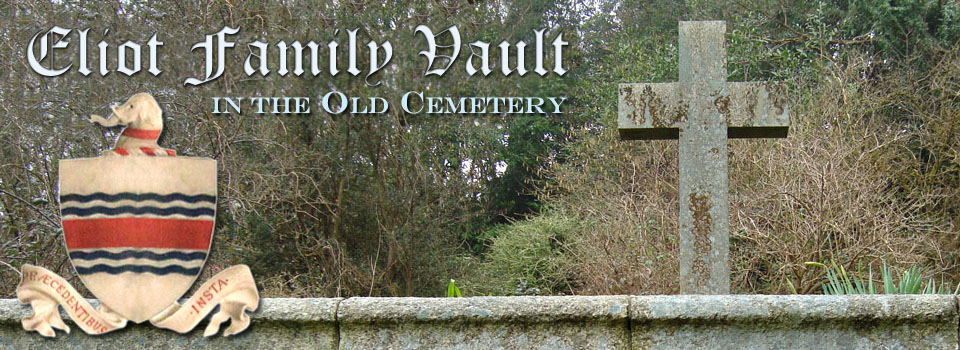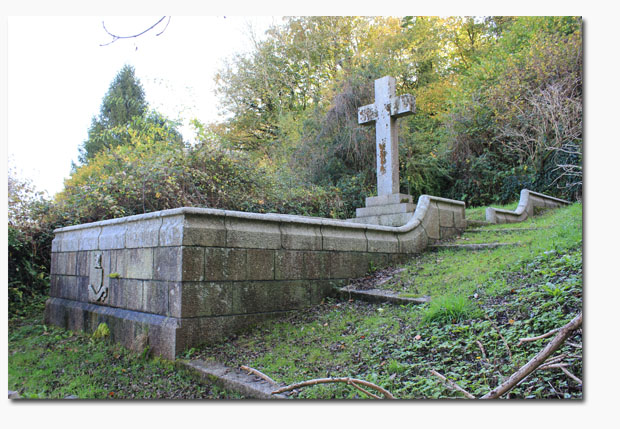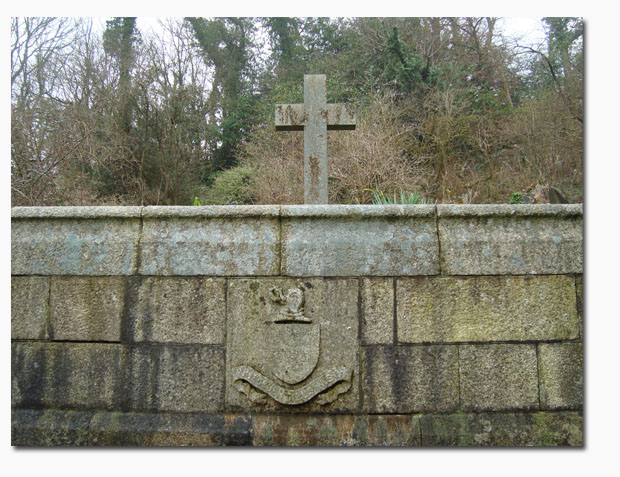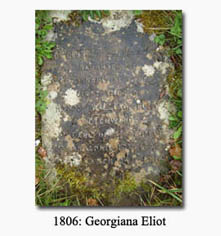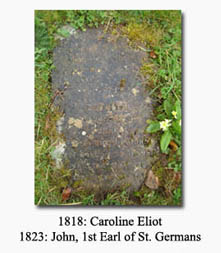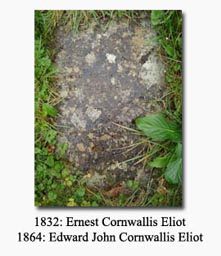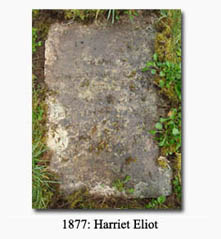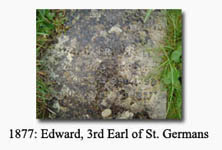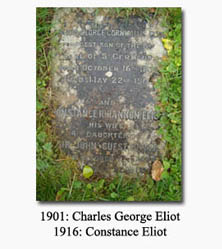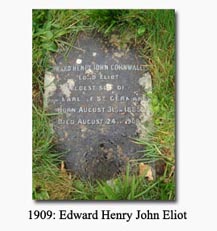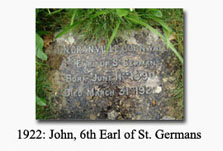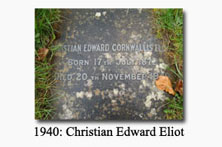The Eliot Family Vault in the Old Cemetery, St. Germans
During the 16th through 18th centuries, the Eliots of Port Eliot laid their dead to rest in the family vault below the altar of the St. German's Church Lady's Chapel. During this same period, three members of the family were even buried (by the church) in a small vault below the Chancel window, just outside the church, overlooking the garden at Port Eliot. The newest family vault is situated in the "old" St. Germans Cemetery on Church Street.
Removal of the Old Churchyard
The history of this third Eliot vault begins in the last half of the 18th Century. For hundreds of years, the local parishioners were buried in the ground between the church and the Port Eliot mansion, which served as the churchyard of St. German's (dating back to the time when the mansion house was the monastery attached to the church itself). The old churchyards were far from being clean or beautiful, and one can only imagine how it must have smelled and looked to the Eliots to have that just outside of their dining-room windows.
Evidently, this unsanitary and unsightly arrangement was unacceptable to Edward, 1st Lord Eliot, because he applied for and was granted a faculty for the erection of a new churchyard in 1771, even donating a piece of land (about a quarter of a mile to the West) for the purpose. This business of transferring the burial remains from the old churchyard to the new was completed between 1780 and 1784. While Lady Eliot superintended the removal of the old churchyard, Lord Eliot had a new family vault constructed at the Eastern end of the new churchyard. This structure was completed before 1784 but was not used until the double funeral of the same Lord and Lady Eliot themselves in 1804.
While the improved health of the Port Eliot family can be dated to the very time of the removal of what would be considered a severe health threat in today's time, the removal of the old churchyard did not sit well with the St. Germans villagers, who resented the "disturbing" of the bones and memorials. We are told, by one of the girls so employed, that Port Eliot staff carted headstones and carried baskets of bones to the new churchyard for months. Much of the work was superintended by Lady Eliot, during which she fell through a grate and into an empty grave, leaving her "lamed for life". The villagers considered this a judgment on poor Lady Catherine.
The "New" Eliot Family Vault
The third family vault was built on the slope of a steep hillside, now hidden from the road by a stone retaining wall and overgrown bushes. The inside compartment of the vault is a rectangular chamber, measuring about 30 feet long. Built in three tiers, large grey stones (presumably from some local quarry) formed the outer walls and ceiling, which were then surmounted by a matching stone border (or kerb). The top of the vault was covered in earth and grass, and a large granite cross was erected in the center of the area in 1803.
On the north end of the vault is a stone carving of the Eliot family arms, showing the striped shield and elephant crest. Since this carving shows only the original family arms (without the coronet or supporters belonging to the arms of Baron Eliot), it is certain proof that the vault was constructed before January 1784. Lord Eliot would, most certainly, have used his newly granted arms, had the vault been constructed after that time.
Twelve stone memorial plaques lie flat in the grass along the top of the vault, recording the names and dates of the first seventeen Eliots buried in the chamber below. Judging from the uniformity of the stones and the information carved on each (complete with errors), it seems most likely that the first seven stones (memorializing ten Eliots) were laid at the same time in the 1890s, when the memorial plaque for the church vault was hung in St. German's Church. The other five stones were added later (as neccessary) in a similar style. All twelve of the plaques are now badly deteriorated, with many of the letters chipped away, and the last three burials remain unmarked.
Descriptions of this vault have varied over time, due to the active imaginations of overzealous newspaper reporters. In fact, this is most evident in the earliest description of an Eliot funeral at this vault, that of Edward Granville Eliot, 3rd Earl of St. Germans and Lord Lieutenant of Ireland, in 1877. The "Royal Cornwall Gazette" reported as follows: This vault was built by the first Baron Eliot, and now contains ten interments. It is a red brick and slated structure, slightly overgrown with ivy. The service here was said by the vicar, and after it the majority of those present entered the vault and took a last look at the coffin. Since the Eliot vault is neither red brick nor slated and can only be entered by lowering the coffin down through a series of flat granite slabs on the top of the structure (below which the coffins are simply stacked, one on top of the other, in the chamber), it is apparent that this reporter had never even gone to the St. Germans cemetery or attended the Earl's funeral.
This fictitious report was copied in other papers across the country, with one paper calling it "the family mausoleum". The "Worcester Journal" featured a similar (though much gloomier) description of the same funeral: . . . in a few moments was reached the gloomy tomb within whose walls lie the mouldering remains of the first Baron Eliot, and eight of his successors, the late Earl numbering the tenth member who has here found his final earthly abode. The Rev. A. Furneaux read the concluding portion of the service, and the corpse was placed by the side of that of the late Countess. Mourners and friends entered the vault and took a last look at that which concealed the form of him beloved by the one and esteemed by the other, and then the mouth of the tomb was closed upon Edward, Earl of St. Germans and his forefathers. Here again, there is no "mouth" of the vault, and the most that could be hoped for was a glimpse of a stack of coffins beheld from the top of a slab-sized hole.
In 1922, the "Western Morning News" reported on the funeral of John Granville Eliot, 6th Earl of St. Germans, with a very accurate description of the vault itself and the funeral as follows:
The family vault lies on the slope of the hillside, between the railway and the high road, and is hidden from both by yew trees and laurels. Several simply-inscribed tablets on its surface record the names of the members of the family . . . Owing to the slope of the ground the vault is in three tiers; it is enclosed by a high kerb and surmounted by a large plain granite cross which bears the date of its erection, 1803. [Small error: This cross was actually erected in 1903 by Henry, 5th Earl of St. Germans.] The final rites were conducted by the Bishop as the coffin was lowered into the moss, ivy, and cherry-blossom-lined grave, concluding with the impressive threefold blessing and the singing of the "Nunc Dimittis." Then commenced a long stream of inhabitants, who filed past . . . throwing sprigs of acacia into the open grave.
In 2004, after twenty burials in exactly two hundred years, the "new" vault was full, the last funeral being that of Lady Frances, Countess of Shelbourne, daughter of the 9th Earl of St. Germans. While the entire churchyard (as well as the vault) is now closed to burials, it is still under the care of the local Council and can be visited during posted hours.

And I heard a voice from heaven saying unto me, Write, Blessed are the dead which die in the Lord from henceforth. Yea, saith the Spirit, that they may rest from their labours; and their works do follow them.
Revelation 14:13
